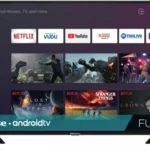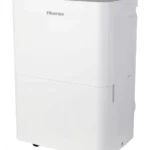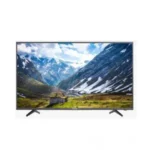
Hisense Ronshen MWB414C.05 WiFi Bluetooth Module

The product description
The user can achieve the terminal equipment connection WIFI net and Bluetooth, through this module This equipment may be operated in all European countries.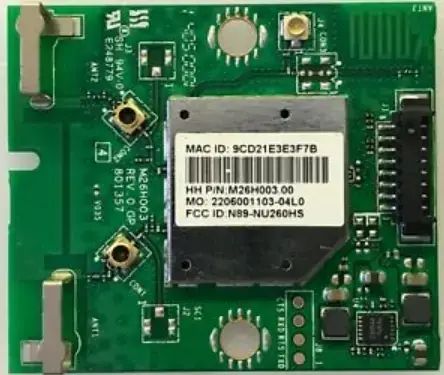
Interface
Interface
4pin through hole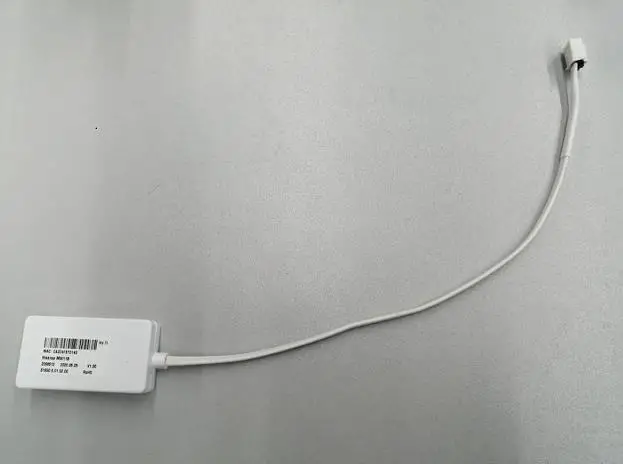
Pin definition
| Pin | Name | Function | Remarks |
| 1 red | VCC_5V | 5V | |
| 2 white | UART0_TX | UART0_TX | I/O |
| 3 green | UART0_RX | UART0_RX | I/O |
| 4 black | GND | GND |
Power consumption requirements
The maximum working current is not more than 500mA, the instantaneous maximum current is not more than 700mA; In standby mode, the power supply of the module shall be no less than 0.45W, and the power supply current shall be no less than 1A (DC-DC is recommended).
Basic parameters
| Feature Description | Feature Description |
| Model | MWB414C.05 |
| Product Name | WIFI Module |
| Major Chipset | Realtek RTL8720CF |
| WLAN Standard | IEEE 802.11b/g/n |
| Max Power | 18.24dBm |
| BT Standard | BLE4.2 |
| WLAN Frequency Range | 2412MHz-2462MHz |
| BT Frequency Range | 2402MHz-2480MHz |
| Spread Spectrum | IEEE 802.11b: DBPSK, DQPSK, CCK for DSSS (Direct Sequence Spread Spectrum)
IEEE 802.11g: BPSK, QPSK,16QAM,64QAM for OFDM (Orthogonal Frequency Division Multiplexing) IEEE 802.11n: MCS0~MCS7,OFDM |
| Modulation Method | DSSS/DBPSK/DQPSK/16-QAM/ 64-QAM |
| Data Transfer Rate | 802.11b:1,2,5.5,11Mbps
802.11g:6,9,12,18,24,36,48,54Mbps 802.11n:MCS0~MCS7,up to72.2Mbps |
| Antenna Reference | PCB printed ANT |
| Interface | 4pin printed ANT |
| Supply Voltage | 5V±0.5V |
| Dimension | 38×20×3.2mm |
| Operating Temperature | -10°C to 70°C |
| Storage Temperature | -20°C to 85°C |
Note:
Low-Temperature Operation
When the external temperature is lower than -10°C, the modules have an increased risk of damage and face unpredictable risks. Do not use modules at temperatures lower than -10 °C!
The display method of Model approved code
In the factory, the model approve code is pasted on the back shell in a label.
CE Statement
EU DECLARATION OF CONFORMITY
Hisense declares that the radio equipment type Hisense MWB414C .05 is in compliance with Directive 2014/53/EU.
FCC Statement
Please take attention that changes or modifications not expressly approved by the party responsible for compliance could void the user’s authority to operate the equipment.
This device complies with Part 15 of the FCC Rules. Operation is subject to the following two conditions:
- This device may not cause harmful interference, and
- This device must accept any interference received, including interference that may cause undesired operation.
This equipment complies with FCC radiation exposure limits set forth for an uncontrolled environment. This equipment should be installed and operated with a minimum distance 20cm between the radiator & your body.
- Operational use conditions
The module has professional users use condition limitations, Host product manufacturer please ensure giving such warning like “Product is limited to professional users use” in your product’s instruction. - Antenna used
Antenna type Max. Antenna Gain BLE/2.4G Wi-Fi PCB Antenna -1.53dBi - Labelling Instruction for Host Product Integrator
Please notice that if the FCC identification number is not visible when the module is installed inside another device, then the outside of the device into which the module is installed must also display a label referring to the enclosed module. For FCC, this exterior label should follow “Contains FCC ID: 2A4A3FRIDGE-2088”. §15.19 Labelling requirements shall have complied with on the end-user device. Labeling rules for a special device, please refer to §2.925, § 15.19 (a)(5), and relevant KDB publications. For E-label, please refer to §2.935. - Installation Notice to Host Product Manufacturer
The OEM integrator is responsible for ensuring that the end-user has no manual instruction to remove or install a module. The module is limited to installation in mobile applications, a separate approval is required for all other operating configurations, including portable configurations with respect to §2.1093 and different antenna configurations. - Antenna Change Notice to Host manufacturer
If you desire to increase antenna gain and either change antenna type or use same antenna type certified, a Class II permissive change application is required to be filed by us, or you (host manufacturer) can take responsibility through the change in FCC ID (new application) procedure followed by a Class II permissive change application. - FCC other Parts, Part 15B Compliance Requirements for a Host product manufacturer
This modular transmitter is only FCC authorized for the specific rule parts listed on our grant, host product manufacturer is responsible for compliance to any other FCC rules that apply to the host not covered by the modular transmitter grant of certification.
Host manufacturer in any case shall ensure host product that is installed and operating with the module is in compliance with Part 15B requirements.
Please note that For a Class B or Class A digital device or peripheral, the instructions furnished the user manual of the end-user product shall include the statement set out in §15.105 Information to the user or such similar statement and place it in a prominent location in the text of host product manual. Original texts as follows:
For Class B
Note:
This equipment has been tested and found to comply with the limits for a Class B digital device, pursuant to part 15 of the FCC Rules. These limits are designed to provide reasonable protection against harmful interference in a residential installation. This equipment generates, uses and can radiate radio frequency energy and, if not installed and used in accordance with the instructions, may cause harmful interference to radio communications. However, there is no guarantee that interference will not occur in a particular installation. If this equipment does cause harmful interference to radio or television reception, which can be determined by turning the equipment off and on, the user is encouraged to try to correct the interference by one or more of the following measures:
- Reorient or relocate the receiving antenna.
- Increase the separation between the equipment and receiver.
- Connect the equipment into an outlet on a circuit different from that to which the receiver is connected.
- Consult the dealer or an experienced radio/TV technician for help.
For Class A
Note:
This equipment has been tested and found to comply with the limits for a Class A digital device, pursuant to part 15 of the FCC Rules. These limits are designed to provide reasonable protection against harmful interference when the equipment is operated in a commercial environment. This equipment generates, uses, and can radiate radio frequency energy and, if not installed and used in accordance with the instruction manual, may cause harmful interference to radio communications. Operation of this equipment in a residential area is likely to cause harmful interference in which case the user will be required to correct the interference at his own expense.
